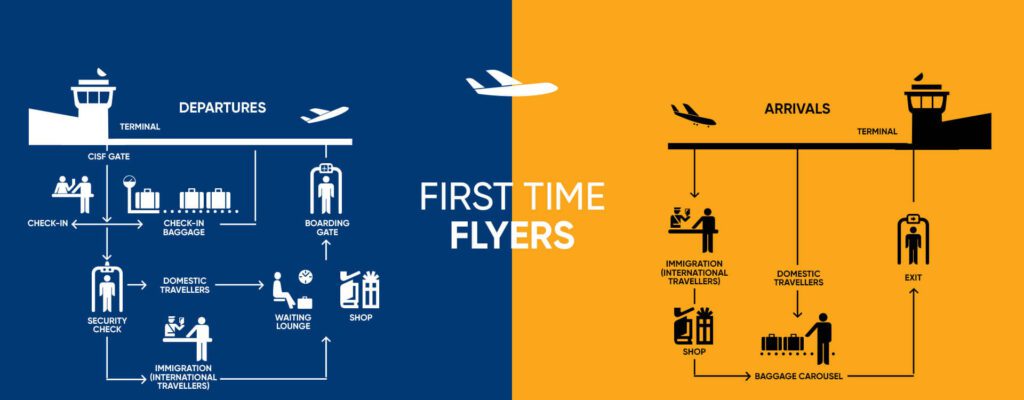Navigating the Airport: A First-Timer’s Guide
Flying for the first time can feel both exciting and a little overwhelming. Airports are large, busy places, and if you’re unfamiliar with how things work, it can be easy to feel lost. But don’t worry! With a little preparation, navigating the airport can be a smooth and stress-free experience. This step-by-step guide will walk you through what to expect and how to make your journey through the airport as easy as possible.

1. Arriving at the Airport
When you first arrive at the airport, aim to get there at least 2 hours before a domestic flight or 3 hours before an international flight. This gives you plenty of time to check in, get through security, and find your gate without feeling rushed.
- Address and Parking: Make sure you know the airport’s address, as it can be easy to miss the entrance. If you’re driving, check for parking options (short-term vs. long-term) and know where the nearest drop-off point is if someone is driving you.
2. Check-in Counter or Kiosk
Once you enter the airport, head to your airline’s check-in counter or use a self-check-in kiosk (many airlines offer these). You’ll need to show your identification (passport or driver’s license) and your flight booking details.
- Domestic Flights: If you already have your boarding pass (either printed or on your phone), you can go straight to security. If not, the check-in counter or kiosk will print it for you.
- International Flights: You’ll also need to show your passport and potentially any additional documents, like a visa, depending on your destination.
3. Baggage Check and Luggage Drop-Off
If you have checked luggage (anything that won’t fit in the overhead bin or under the seat), you’ll need to drop it off at the designated counter or kiosk. Most airlines allow a certain weight and size limit for free checked bags, but keep in mind that extra bags or overweight luggage can come with additional fees.
- Label your bags: Some airports provide tags at the kiosk, but it’s always a good idea to double-check that your bag has been properly tagged for your final destination.
- Carry-on items: If you’re only traveling with carry-ons, you can skip this step. Just make sure your carry-ons follow your airline’s size and weight guidelines.
4. Security Checkpoint
Once your check-in is done, it’s time for security. Here’s what you’ll need to do to pass through smoothly:
- Get in line for security screening.
- Have your ID and boarding pass ready: You’ll need to show both to the security personnel.
- Remove your shoes, belt, and outerwear: You’ll be asked to place these items in a bin, along with your bag, laptop, or anything metal.
- Liquids in a clear plastic bag: If you’re carrying liquids, gels, or aerosols (including toothpaste or cosmetics), make sure they’re in containers of 3.4 ounces (100 ml) or less and placed in a clear, resealable bag (usually 1 quart size).
- Walk through the scanner: After you’ve placed all your belongings in the trays, you’ll step through a metal detector or body scanner. If the machine detects something unusual, you might be asked to go through additional screening.
Once through, gather your items quickly from the conveyor belt and put your belongings back together.
5. Finding Your Gate
After clearing security, the next task is to find your departure gate. Airports can be confusing with their maze-like corridors, but most will have clear signs pointing you in the right direction.
- Check the airport monitors: Look for your flight number and departure time to find the gate. Most airports display this information clearly on large monitors.
- Follow the signs: Once you know your gate, look for directional signs that will lead you there. If you’re unsure, don’t hesitate to ask an airport employee.
6. Time to Relax and Wait
Once you’ve found your gate, it’s time to relax. Airports are usually filled with places to grab a bite to eat, shops, and charging stations for your devices. Here are a few tips for the waiting period:
- Stay near your gate: While you might want to wander around, it’s best to stay relatively close to your gate. Boarding typically starts 30–45 minutes before your flight, and you don’t want to risk missing an important announcement.
- Check your boarding time: The flight attendants will announce boarding instructions once it’s time to board. Listen for your group number or boarding zone, and then line up when it’s called.
- Use the restroom beforehand: It’s always a good idea to use the restroom before boarding to avoid any last-minute dashes to the bathroom once you’re on the plane.
7. Boarding the Plane
When it’s time to board, the airline staff will make announcements about which groups or zones will board first. Boarding typically happens in groups, starting with passengers in first class or those with special needs, followed by economy groups.
- Have your boarding pass ready: The gate agent will scan your boarding pass before you enter the jet bridge or board the plane.
- Find your seat: Once on the plane, follow the overhead signs or ask a flight attendant if you’re unsure of where your seat is. Store your carry-on luggage in the overhead bin or under the seat in front of you.
8. In-Flight Tips
Once you’re on board, the flight attendants will give safety instructions, and the plane will taxi to the runway for takeoff. If you’re feeling nervous, here are a few things to keep in mind:
- Stay hydrated: Airplane cabins are dry, so make sure to drink plenty of water.
- Move around if possible: On longer flights, it’s a good idea to stretch or walk around to keep your blood flowing.
- Sit back and relax: Don’t forget to enjoy the view, read a book, or watch a movie as you’re in the air!
9. Arrival and Baggage Claim
After a smooth landing, your plane will taxi to the gate, and you’ll disembark. Follow the signs to Baggage Claim if you have checked luggage.
- Check the baggage carousel number: Monitors will display the carousel number for your flight’s luggage. Wait at the correct one and collect your bag.
- Customs (if traveling internationally): If you’re coming from another country, you’ll need to go through customs. Have your passport ready and follow the signs to the customs area.
Once you have your luggage, you’re ready to leave the airport!
Final Thoughts
Airports can be overwhelming, but once you get familiar with the steps, the process becomes much easier. Remember to allow yourself plenty of time, keep your documents handy, and stay calm through each stage. And most importantly, don’t forget to enjoy the journey!
Flying for the first time is an adventure in itself. By following these simple steps, you’ll feel more confident and prepared when it’s time to board your first flight. Be sure to check for reservations deal before your next trip to get the best prices and make your travel experience even smoother. Happy travels!

